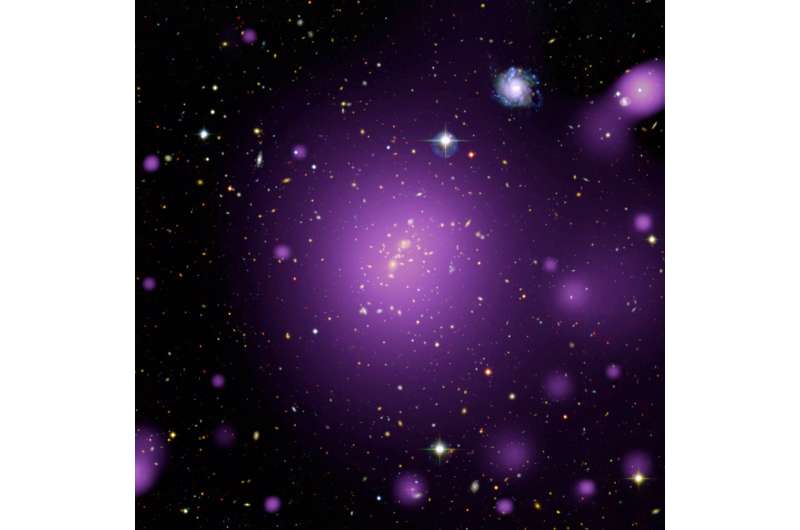Observations challenge cosmological theories

Recent observations have created a puzzle for astrophysicists: Since the Big Bang, fewer galaxy clusters have formed over time than were actually expected. Physicists from the university of Bonn have now confirmed this phenomenon. For the next three years, the researchers will analyze their data in even greater detail. This will put them in a position to confirm whether the theories considered valid today need to be reworked. The study is part of a series of 20 publications appearing in the professional journal Astronomy and Astrophysics.
Nearly 13.8 billion years ago, the Big Bang marked the beginning of the universe. It created space and time, but also all the matter of which our universe consists today. From then on, space expanded at a terrifying rate, and so did the diffuse fog in which the matter was nearly evenly distributed.
But not completely: In some regions, the fog was a little bit denser than in others. As a result, these regions exerted a slightly stronger gravitational pull and slowly attracted material from their surroundings. Over time, matter concentrated increasingly within these condensation points. At the same time, the space between them gradually became emptier. Over 13 billion years, this resulted in the formation of a sponge-like structure—big "holes" devoid of matter, separated by small areas within which thousands of galaxies agglomerate—the galaxy clusters.
Six parameters explain the whole universe
The Standard Model of cosmology describes this history of the universe, from the first seconds after the Big Bang to the current day. The beauty of it: The model explains, with only six parameters, everything known today about the birth and evolution of the universe. Nonetheless, the model may now have reached its limits. "New observational evidence points to the fact that the matter is distributed today in a different way than the theory predicts," explains Dr. Florian Pacaud from the Argelander-Institut für Astronomie of the University of Bonn.
It all started with the measurements of the Planck satellite, which was launched by the European Space Agency (ESA) to measure the cosmic background radiation. This radiation is, to some extent, an afterglow of the Big Bang. It conveys crucial information on the matter distribution in the early universe; showing the distribution as it was only 380,000 years after the Big Bang.
According to the Planck measurements, this initial distribution was such that, over cosmic time, more galaxy clusters should have formed than we observe today. "We have measured with an X-ray satellite the number of galaxy clusters at different distances from ourselves," explains Dr. Pacaud. The idea behind the measurements: The light from remote galaxy clusters has traveled for billions of years before reaching us, so we observe them today as they were when the universe was still young. Nearby clusters, on the other hand, are observed as they appeared much more recently.
"Our measurements confirm that the clusters formed too slowly," said Dr. Pacaud. "We have estimated to which extent this result conflicts with the basic predictions of the Standard Model." While there is a large discrepancy between the measurements and predictions, the statistical uncertainty in the present study is not yet tight enough to challenge the theory. However, the researchers expect to obtain substantially more constraining results from the same project within the next three years. This will finally reveal whether the Standard Model needs to be revised.
Dark energy—a constant?
The study also supplies a glimpse into the nature of dark energy. This mysterious constituent of the universe acts as a kind of interstellar baking powder, causing the acceleration of cosmic expansion. The "amount" of dark energy—the cosmological constant—should have stayed the same since the Big Bang—or so assumes the Standard Model of cosmology. Many observations seem to point in this direction. "Our measurement also supports this thesis," explains Dr. Pacaud. "But here again, we shall obtain more precise results in the near future."
More information: F. Pacaud et al, The XXL Survey. XXV. Cosmological analysis of the C1 cluster number counts, Astronomy & Astrophysics (2018). DOI: 10.1051/0004-6361/201834022
Journal information: Astronomy & Astrophysics
Provided by University of Bonn





















